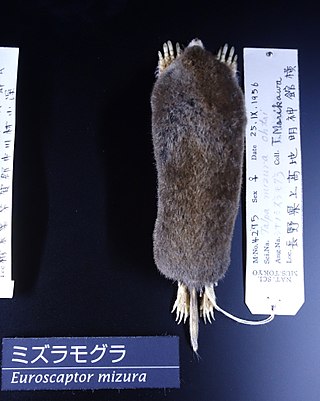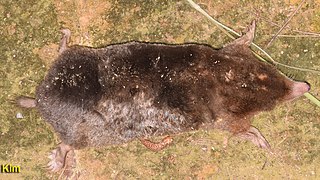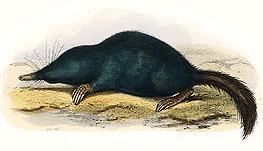
The family Talpidae includes the moles who are small insectivorous mammals of the order Eulipotyphla. Talpids are all digging animals to various degrees: moles are completely subterranean animals; shrew moles and shrew-like moles somewhat less so; and desmans, while basically aquatic, excavate dry sleeping chambers; whilst the quite unique star-nosed mole is equally adept in the water and underground. Talpids are found across the Northern Hemisphere of Eurasia and North America, and range as far south as the montane regions of tropical Southeast Asia.

The subfamily Talpinae, sometimes called "Old World moles" or "Old World moles and relatives", is one of three subfamilies of the mole family Talpidae, the others being the Scalopinae, or New World moles, and the Uropsilinae, or shrew-like moles.

The hairy-tailed mole, also known as Brewer's mole, is a medium-sized North American mole. It is the only member of the genus Parascalops. The species epithet breweri refers to Thomas Mayo Brewer, an American naturalist.

The Japanese mole, also known as Temminck's mole, is a species of mole endemic to Japan. A solitary and diurnal species, it can live for up to 3.5 years in the wild. Their sizes vary depending on the temperature and the hardness of the soil they reside in.

Kano's mole is a species of mole endemic to Taiwan. The specific name kanoana is derived from Tadao Kano, a Japanese naturalist who made the first record of these animals in 1940s.

The Japanese mountain mole is a species of Old World mole in the family Talpidae. It is endemic to Japan. It is the only member of the monotypic genus Oreoscaptor. Its natural habitats are temperate forests and temperate grassland.

The Echigo mole is an endangered species of mammal in the family Talpidae. It is endemic to Japan, being found only on the Echigo plain, Niigata prefecture.

The insular mole is a species of mammal in the family Talpidae. It is restricted to Hainan Island and Taiwan, where it is also known as the Formosan blind mole. The species was first described by Robert Swinhoe in 1863.

The Ussuri mole or large mole, is a species of mammal in the family Talpidae, formerly treated as a subspecies of the Japanese mole. It is found in China, North Korea, South Korea, and Russia and lives in a long burrow, seldom emerging on the surface of the ground during the day.

The Sado mole or Tokuda's mole is a species of mammal in the family Talpidae. It is endemic to Sado Island, Japan.

The Senkaku mole, also known as the Ryukyu mole, is a species of mammal in the family Talpidae. It was formerly classified as being the only species in the genus Nesoscaptor. It is endemic to the Uotsuri-jima of the disputed territory of Senkaku Islands, also known as the Diaoyutai Islands. It is most similar to the Insular mole of Taiwan and mainland China.

The Gansu mole is a species of mammal in the family Talpidae endemic to central China, where it occurs in Shaanxi, Gansu, Sichuan, and Qinghai. It is the only species in the genus Scapanulus.

True's shrew mole is a species of mammal in the family Talpidae. It is endemic to Japan and is a common species above 1000 meters in grassland, shrubland and forest. Sometimes this species is called the lesser Japanese shrew mole and another species, Urotrichus talpoides, is called the "greater Japanese shrew mole".

The Japanese shrew mole or himizu (ヒミズ) is a species of mammal in the family Talpidae. It is endemic to Japan and is found on Honshu, Shikoku, Kyushu, Awaji Island, Shodo Island, Oki Islands, Tsushima Island, Goto Islands, Mishima Island, and Awashima Island, but is absent from Hokkaido, which is north of Blakiston's Line. It is one of three Urotrichini and it is the only extant species in the genus Urotrichus. It is common between sea level and approximately 2,000 m. Sometimes this species is called the greater Japanese shrew mole and another species, True's shrew mole, is called the "lesser Japanese shrew mole".

Talpini is a tribe of mammals known as Old World moles. It is a division of the subfamily Talpinae.

The Malagasy mountain mouse or Koopman's montane voalavo is a rodent within the subfamily Nesomyinae of the family Nesomyidae. It is monotypic within the genus Monticolomys, and is closely related to the big-footed mouse (Macrotarsomys). It is found in the highlands of eastern Madagascar. A small mouse-like rodent, it is dark brown on the upperparts and dark gray below. It has small, rounded, densely haired ears and broad feet with well-developed pads. The long tail lacks a tuft at the tip. The skull is delicate and lacks crests and ridges on its roof.

La Touche's mole is a species of mammal in the family Talpidae. It is found in eastern China and parts of northern Vietnam. It is named after Irish naturalist John David Digues La Touche.

















